|
NEWSPAPER ARTICLE 20155955_10209305603772744_7739807946538838669_n.jpg |
|
ONE OF TWO SHIPS THAT BOMBARDED ILOILO CITY ON FEBRUARY 11, 1899 PRIOR TO THE LANDING OF U.S. TROOPS IN PANAY ISLAND |
| 13 PHOTOS BY SCOTT SLATEN |
|
NEWSPAPER ARTICLE 20155955_10209305603772744_7739807946538838669_n.jpg |
USS Boston joined by USS Petrel in shelling Panay Island February 11, 1899 To the southward of Luzon the most important naval operations in 1899 were at Panay, whose capital Iloilo was the second port in the archipelago. In the capture of this port the naval vessels Boston, Captain G. F. F. Wilde, and Petrel, Commander C. C. Cornwell, cooperated with a division of the army under General Miller. On February 10, Miller addressed an ultimatum to the insurgents at Iloilo demanding their withdrawal before sunset of the following day and forbidding them to erect additional defenses under penalty of bombardment. On the morning of the 11th they began to improve their defenses; and the Boston and Petrel opened fire on them, and forced them to abandon their guns and retreat. A landing party, drawn from both vessels and commanded by Lieutenant A. P. Niblack, of the navy, now went ashore, took possession of the enemy's intrenchments, and occupied the town. In these operations the Americans lost one man wounded; the loss of the Filipinos was probably slight. The enemy attempted to fire the town before abandoning it, but by the prompt action of Niblack this was prevented. The American, British and German consulates and the Filipino and Chinese quarters, however, were burned. After holding the city for an hour, Niblack turned it over to General Miller." On February 20 Commander Cornwell, having received orders from Wildes to take possession of Cebu, the capital of the island of the same name, sailed from Iloilo, with the Petrel, for that town. [Source: United States Naval Institute Proceedings, March 1912]
later renamed Despatch (IX-2) USS Boston, a 3189-ton Atlanta class protected cruiser, was built at Chester, Pennsylvania, and commissioned in May 1887. One of the first ships of the "New Navy", she operated actively in the Atlantic until 1891. For much of that time she was a member of the Squadron of Evolution, and cruised with that unit to the Mediterranean Sea and South America between early December 1889 and late July 1890. In 1891 Boston went around Cape Horn to the Pacific, where she spent the rest of her career. During much of 1892 and 1893 she was stationed in Hawaii and in November 1893 was laid up at the Mare Island Navy Yard, California. Recommissioned in November 1895, Boston crossed the Pacific to take station in Asiatic waters. During the Spanish-American War in 1898, she participated in the Battle of Manila Bay and in subsequent operations in the Philippines. After her return to the U.S. in August 1899 the cruiser was laid up at Mare Island. She returned to active duty in August 1902 for operation with the Pacific Squadron. In June 1905 she represented the Navy at the Lewis and Clark Exposition at Portland, Oregon, and in April and May 1906 assisted with earthquake recovery efforts at San Francisco, California. Boston's seagoing Navy career ended in June 1907. Inactive at the Puget Sound Navy Yard until June 1911, she then began a tour as Oregon Naval Militia training ship, remaining in that position until September 1916. During much of the First World War the ship was on loan to the United States Shipping Board, but in 1918 Boston was converted for use as the receiving ship at the Yerba Buena Naval Training Station in San Francisco Bay. More than two decades later, in August 1940, she was renamed Despatch, thus freeing her original name for use on the new heavy cruiser CA-69. She was given the hull number IX-2 in February 1941 and remained at Yerba Buena through the Second World War. Following almost sixty years' service, the old ship was sunk as a target off San Francisco in April 1946. U.S. Naval Historical Center |
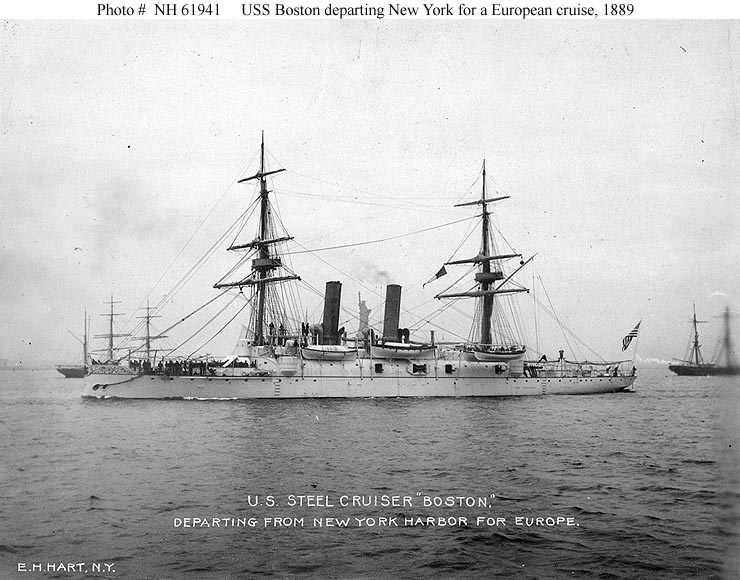 Photo #: NH 61941. USS Boston (1887-1946). Departing New York Harbor for a European deployment, circa December 1889. The Statue of Liberty is in the background, between Boston's two smokestacks. Photographed by E.H. Hart. U.S. Naval Historical Center Photograph. 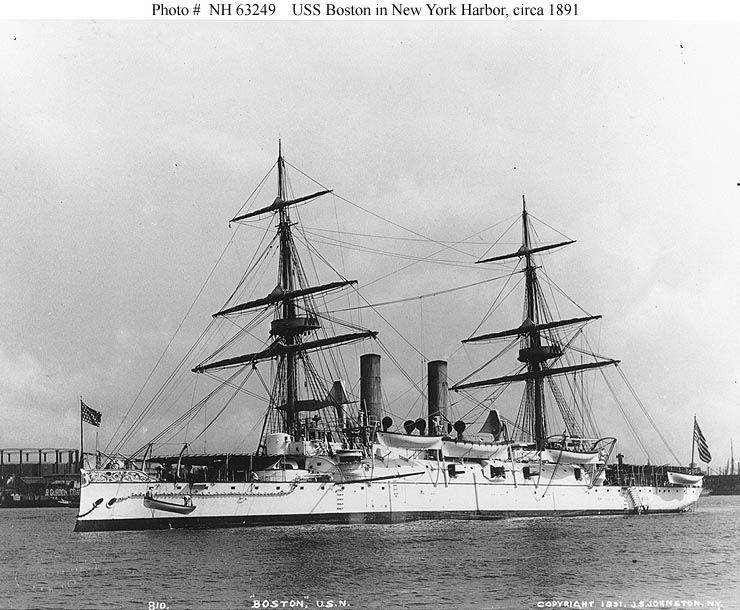 Photo #: NH 63249 USS Boston (1887-1946) In New York Harbor, circa 1891. Photographed by J.S. Johnston, New York. U.S. Naval Historical Center Photograph. |
Official Profile of USS Boston
(Displacement: 3,189 tons; length: 283'; beam 42'; draft 17'; speed 13 knots; complement 284; armament 2-8", 6 6"; class Boston) The fifth Boston, a protected cruiser, was launched 4 December 1884 by John Roach and Sons, Chester, Pa., and commissioned 2 May 1887, Captain F. M. Ramsey in command. Boston, being the second cruiser of the New Navy completed, was not ready for active service until 1888. She then made a cruise to Guatemala and Haiti to protect American citizens. She joined the Squadron of Evolution 30 September 1889 and cruised to the Mediterranean and South America (7 December 1889-29 July 1890), and along the east coast in 1891. Boston departed New York 24 October 1891 for the Pacific, via Cape Horn, arriving at San Francisco 2 May 1892. Except for a cruise to protect American interests in Hawaii (11 August 1892-10 October 1893), she remained on the west coast until laid up at Mare Island Navy Yard 4 November 1893. Recommissioned 15 November 1895, Boston joined the Asiatic Station at Yokohama, Japan, 25 February 1896. She remained in the Orient protecting American interests for the next four years and during the Spanish-American War took part in the Battle of Manila Bay (1 May 1898) and the capture of Manila (13 August 1898). She remained in the Philippines assisting in their pacification until 8 June 1899. Boston returned to San Francisco 9 August 1899 and went out of commission at Mare Island Navy Yard 15 September 1899. She remained out of commission until 11 August 1902 and then rejoined the Pacific Squadron. During 16-25 June 1905, she helped represent the Navy at the Lewis and Clark Exposition at Portland, Oreg., and between 23 April and 10 May 1906 she helped care for the victims of the San Francisco earthquake and fire. She went out of commission again at Puget Sound Navy Yard 10 June 1907. From 15 June 1911 to September 1916 she served as a training vessel with the Oregon Naval Militia and was loaned to the Shipping Board (24 May 1917-June 1918). On 18 June 1918 she was recommissioned at Mare Island Navy Yard as a receiving ship and towed to Yerba Buena Island, Calif., where she served as a receiving ship until 1946. She was renamed Despatch 9 August 1940 and reclassified IX-2, 17 February 1941. Despatch was towed to sea and sunk off San Francisco 8 April 1946. Dictionary of American Naval Fighting Ships |
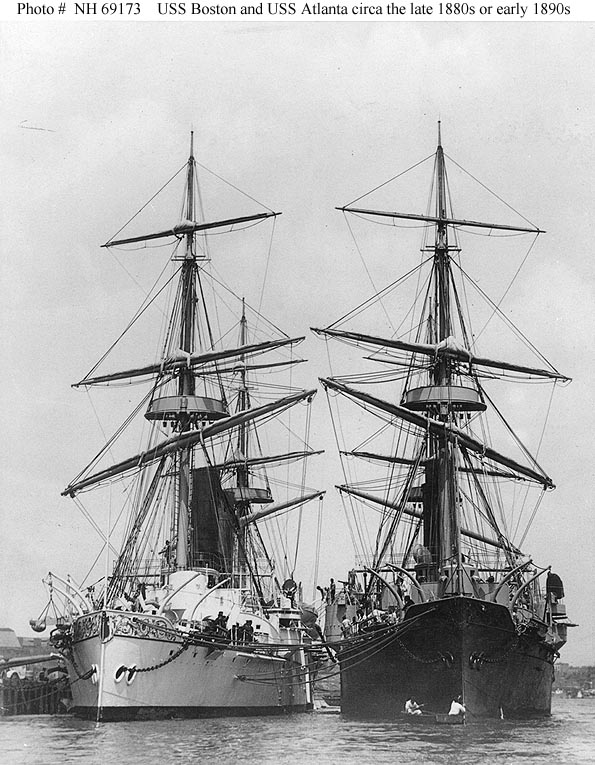
|
Photo #: NH 69173. USS Boston (1887-1946), left and USS Atlanta (1886-1912). Tied up together, probably at the New York Navy Yard, circa the late 1880s or early 1890s. Note that their yards have been cocked to avoid striking each other. U.S. Naval Historical Center Photograph. |
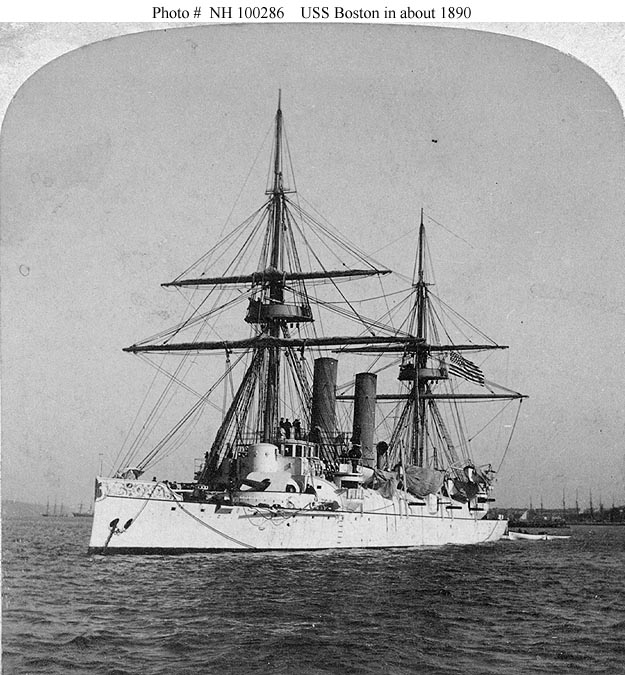 |
Photo #: NH 100286 USS Boston (1887-1946) Photographed circa 1890. The original photograph was printed on a stereograph card, published by Strohmeyer and Wyman, 1898. Donation of Louis Smaus, 1985 U.S. Naval Historical Center Photograph. A stereo pair version of this image is available as Photo # NH 100286-A |
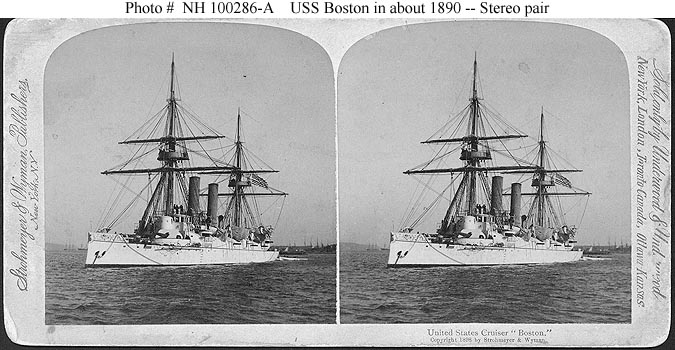
|
|